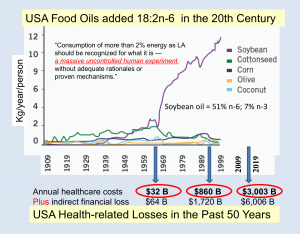Modern Access to Food
People tend to eat whatever “food” is available. However, modern cultivation, transport, processing and global marketing of food has greatly changed the year-round supply of food. Throughout the late 20th century American families increasingly ate more meals prepared outside the home. New prepared foods and “fast” foods give needed protein, energy and essential nutrients in amounts different from simple foods that humans have eaten for many thousands of years.
prepared outside the home. New prepared foods and “fast” foods give needed protein, energy and essential nutrients in amounts different from simple foods that humans have eaten for many thousands of years.
Rapid food changes in the 20th century were made without public awareness that intakes of n-3 and n-6 essential fatty acids were being altered. Food technology put seed oils into the food environment for humans more than had ever been available before. A rapid rise of omega-6 linoleic acid (18:2n-6) in American diets occurred after 1960 (click Figure on the right for details).
At that time, medical experts believed that fats in American diets, when eaten in large amounts contribute to hypercholesterolemia and inflammatory atherogenesis. Only after many more years did researchers learn the complex network of metabolic steps controlling how much food energy is converted to blood cholesterol.
Several health agencies, believing that blood cholesterol causes vascular inflammation, advised the public to lower cholesterol by eating more polyunsaturated fats. This led to vigorous production, marketing and consumption of soybean oil. However, scientists later observed that circulating cholesterol levels predict risk of CHD death only to the degree that pro-inflammatory HUFA exceed less-inflammatory HUFA. In the 1960’s and 1970’s, potent hormone-like n-6 eicosanoids were discovered to be formed from dietary linoleate (18:2n-6). The n-6 eicosanoids amplify many unwanted inflammatory conditions. The Figure above shows that a large rise in American healthcare costs occurred along with the rise in linoleate (18:2n-6) intake. Gene differences make the dietary impact even greater for African Americans.
The increased intake of omega-6 linoleic acid (18:2n-6) during the past 50 years is evident in the steadily increased content of linoleic acid accumulating in adipose fat (see Figure below). “Western” diets give a higher amount of omega-6 in HUFA than traditional Mediterranean or Japanese diets. The result is that Americans now have many opportunities for RECIPE REPAIR using Omega Meals software. Eating seafoods is an easy way to shift HUFA balance to lower the risk for excess omega-6 actions. While food choices alone CAN give a desired HUFA balance, some daily food combinations don’t succeed. That’s when many people use fish oil supplements to reach their goal while they continue eating prepared foods that have fairly negative scores.
The consequence of having different ethnic foods with different balances of omega-6 and omega-3 EFA nutrients is that the HUFA balance in apparently healthy people ranges from 20% to 85% omega-6.Those tissue HUFA balances relate to the risk for many unwanted inflammatory conditions and are a useful health risk assessment measurement. They can be measured in a simple finger-tip blood-spot test.
updated February, 2021
